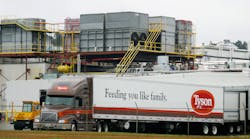When you visit a meat plant, humans are completing tasks like stacking pallets and packing chicken drumsticks. But Tyson Foods Inc. thinks robots can do it all.
The U.S. meat giant is betting that automation and robotics can alleviate a worker shortage that has long hampered the industry. The company has built the 26,000-square-foot, multi-million dollar Tyson Manufacturing Automation Center near its headquarters in Springdale, Arkansas. At the facility, engineers will apply the latest advances in machine learning to meat manufacturing, with the goal of eventually eliminating jobs that can be physically demanding, highly repetitive and at times dangerous.
As global demand for meat rises, producers have had a hard time attracting enough workers to keep up with rising consumption. Some in the industry have pointed to Donald Trump’s tough stand on immigration as exacerbating the U.S. labor shortages. Producers including Pilgrim’s Pride Corp. and Cargill Inc. have boosted pay in some cases, and offered other benefits like new housing, health care and transportation incentives.
“We’ve got to get out in front of this,” said Marty Linn, the director of the new center who, before coming to Tyson, spent 30 years at General Motors Co. “We’re not going to outsource” these tasks, “we’re going to produce them here in this country, so automation is a key strategy for us going forward,” he said.
Advances in technology are making it possible to make strides in automation. For example, machine vision is now accurate and speedy enough to apply to meat production, which is highly labor intensive compared with other food manufacturing. Also, a lot of washing and sanitizing occurs in a meat-packing plant, which has traditionally been difficult on robots, but now the machines are built to withstand that.
At Tyson’s new facility, a series of laboratories showcase different types of robots. Mechanical arms in glass cases use smart cameras to sort colorful objects or stack items. In another room, a larger machine called a palletizer performs stacking tasks. There’s also a training space.
Many of the types of robots that a meatpacking plant would need are not on the market currently, so the company needs to innovate and collaborate with partners to create them, said Doug Foreman, a director in engineering at Tyson. But the technology is ready.
The processing capabilities of cameras are “so advanced even from a few years ago,” Foreman said. “Processing-speed-wise, it’s there now for us.”
A shortage of labor is one of the biggest impediments to growth in the meat industry, said Will Sawyer, an animal protein economist at the $138 billion rural lender CoBank ACB.
“If there was enough available labor, we would see more protein on the market, especially on the pork and poultry side,” he said.
While the U.S. labor supply as a whole is at historically low levels, the problem is more acute in meat production. The industry has struggled with a reputation of difficult working conditions since the days of Upton Sinclair, the American author who wrote of abuses in his 1906 novel, “The Jungle.” Tyson just this month had a fatal accident involving pallets in its Amarillo plant. The industry often relies on immigrant workers to fill jobs that middle-class Americans shun.
Tyson has worked to improve working conditions, including by using more ergonomic equipment. More automation can also mean improvements for employees.
Meanwhile, Trump’s extreme rhetoric and policies on immigrationーincluding raids on meatpacking plantsーhasn’t helped as some potential workers are now too fearful to fill openings. U.S. Immigration and Customs Enforcement officials raided chicken facilities in Mississippi on Wednesday. The state is the fifth-largest for chicken production, but Tyson Foods and Sanderson Farms facilities in the state weren’t affected, according to a report from a JPMorgan analyst Ken Goldman.
“With labor so important to the industry and increasingly scarce in today’s tight job market, any reductions in personnel supply would lead to incrementally higher costs,” Goldman said.
By Lydia Mulvany




